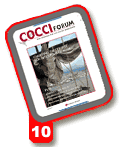SPECIAL REPORT: Charting the Course for Intestinal Health
Specialists discuss IDEA concept, address new opportunities for feed management when vaccinating broilers for coccidiosis.
 |
Vaccinating for coccidiosis has hatched many new ideas
in broiler nutrition as poultry companies break free from
the rigid feeding schemes once mandated by in-feed
anticoccidials.With more progressive companies leaning
toward vaccination as their primary and, in some cases, exclusive
means of coccidiosis control, they're finding they can
build their nutrition programs around the needs of the birds,
not the prescribed regimen or withdrawal time of a coccidiosis
drug.
This trend gave birth to the IDEA concept, a new approach to
managing broiler feeds. IDEA stands for Impulse, Digestibility,
Economic and Advance "all key concepts that make up the
concept's foundation.
"The IDEA concept seeks to enhance immunity development
and reduce intestinal challenges by coccidia and bacteria without
the use of drugs, while also giving poultry companies the
opportunity to better manage nutrition for birds," says Fabio
Paganini, senior product manager for Schering-Plough Animal
Health Corporation. "It potentially reduces feed costs while
conditioning the gut for better coccidiosis management.
" With these benefits in mind, Schering-Plough Animal Health
recently hosted a symposium, "New Paradigms in Poultry
Nutrition and Management," in Madeira, Portugal. The event
attracted nutritionists from more than 30 leading poultry
companies worldwide.
Managing editor Joe Feeks, who attended the conference and
then talked with each speaker regarding the take-away messages
from their presentation, filed this report. For a free copy
of the conference proceedings, send your name, address and
phone number to [email protected].
IDEA: Making nutrition, management and environment part of coccidiosis management
Dr. Rick Phillips - Schering-Plough Animal Health USA Dr. Rick Phillips |
Phillips reviewed the principles of
IDEA, insisting it was a "concept"
wide open to customization,
not a rigid program for all poultry
companies to follow.
"We're trying to bring all the production
disciplines such as live production
managers, veterinarians, physiologists,
and the nutritionists together to
talk about the nutritional needs of the
birds "not just the good aspects, but
those that may have a negative impact
on another discipline," he said.
For example: If management
changes a lighting program to help
them manage the bird, that could have
an impact on feed intake, which could
have a negative effect on the bird.
"That might override the positive
effect they achieved on the management
side," Phillips said, "so it's important
to have all the production disciplines
in the room to talk about the
true needs of the birds. That way, poultry
companies can put all their recommendations
on the table and make sure
there aren't conflicts. This isn't a new
concept, but the industry has gotten
away from it over the years. We also
know that drugs can also cover up a lot
management flaws."
Phillips reminded the audience that
subclinical coccidiosis is still the number
one cause of performance loss in
the world poultry industry today, either
as a primary or secondary disease
agent. Without vaccination or other
new strategies for coccidiosis control,
the full genetic potential of the bird will
not be realized, and large amounts of money will be left "on the table."
The veterinarian stressed that birds
vaccinated for coccidiosis don't necessarily
need more management than
those on medicated feeds, but not having
drugs in the feed can give nutritionists
more flexibility. This, in turn,
can lead to more effective and efficient
use of various feedstuffs.
"For decades producers have been
building their feed program around infeed
anticoccidials, as well as growth
promoters," he said. "Now that we are
pulling these drugs away, we have to
do things differently "for the simple
reason that we're using products that
work differently. We need the various
production disciplines to understand
how the vaccine works, how the
Eimeria pathogens work, and what the
host response is to that parasite. Then
poultry companies can build a new
program around that new strategy."
Phillips said resistance problems
with overused in-feed anticoccidials,
which are generally in the feed from 0
to 35 days, have led to "an erosion of
performance" in the field. Vaccination
gives producers the opportunity to "gain some of that back," he added, by breaking up the continuous use of these products and perhaps eliminating them altogether. Producers can then stop worrying about drug residues in the feed mill and withdrawal times for in-feed anticoccidials, which reduce
marketing flexibility.
"As the IDEA concept points out,
the first 14 days, 15 to 28 days, and
then 30 days and beyond are key windows
of time," Phillips explained."With IDEA, the nutritionist can look at
that time frame and build nutritional
packages based on the nutritional
needs of the bird, instead of the rotation
schedule of the in-feed medications
or the withdrawal times of the
drugs that were in the feed initially."
Phillips said that with the improved
genetic potential of today's birds comes
increased demand on the intestinal
tract for maximum digestion and
absorption. A comprehensive understanding
of the intestinal physiology is
therefore imperative. "Trials have confirmed
that performance is enhanced
when digestibility of the protein fed is
improved during the time that immunity
is developing," he added.
The poultry veterinarian then
addressed the four components of the
IDEA concept, which he called a "simple
yet innovative approach to feed
management" that redefines the birds' nutritional and management needs during
critical phases of grow-out:
Impulse (0-14 days)
The main focus here is intestinal and immune system development. Optimum protein and energy levels, as well as vitamins and trace mineral supplementation, should be critically reviewed and evaluated in the starter (impulse) feeds, Phillips advised.
"Newly hatched chicks need immediate
access to solid feed and water to
set the stage for good performance
later," he said. "Birds need to achieve
maximum duodenum villi development
in the first week."
In the Impulse stage, intestinal
microflora are getting established, and
bones and muscles are formed at maximum
efficiency. This stage also determines
the number of enterocytes
for the rest of the birds' life, so it's critical
to guarantee their maximum
development.
Digestibility (15-28 days)
Intestinal irritation can open the door to secondary invaders, especially bacteria. Abrasive or less digestible ingredients in the grower feeds therefore should be replaced with high quality, highly digestible ones. Dietary changes should be avoided at 15 to 21 days to prevent intestinal disruption.
Phillips suggested providing high quality feed and an optimal enzyme dosage, while adjusting protein levels as needed because excess, undigested protein encourages overgrowth of undesirable bacteria. Dietary fat should also be of high quality and easily digestible.
Economic (>30 days)
Here's where poultry companies can
cash in. Immunity is now established
and birds have the maximum growth
potential.
Feed consumption also
peaks. The strategy now is to focus on
maximizing feed efficiency and daily
gain, while the vaccine provides lifelong
protection against coccidiosis.
Advance
The implementation of the IDEA concept represents an advancement in the traditional thinking with respect to manipulation of immunization, management and nutrition to help improve overall flock performance.
IMPULSE: Maximizing the performance of the intestinal tract immune system
Dr. Andrea Ribeiro - Universidade Federal do Rio Grande do Sul Brazil Dr. Andrea Ribeiro
|
It might only take 35 to 50 days for
a broiler chick to reach market
weight, but its intestinal system
changes markedly in that brief lifetime.
'The anatomy and the physiology of
young chicks are completely different
from older birds," Ribeiro said. "They
absorb fewer nutrients, so we have to
feed them in a different way."
Ribeiro said the chick's intestinal
system is not fully developed until 7 to
10 days. "All the feed they eat is to
develop the intestinal tract," she
explained. "That's very important
because the healthier and bigger their
intestines, the more nutrients they will
absorb in the grow-out period."
She said broilers achieve maximum
relative weight of digestive organs
when they are between 3 and 8 days of
age, with the highest increase in the
volume of villi of the duodenum occurring
when broilers are 4 days old.
Development of the jejunum and ileum
peaks at 10 days, while the highest
crypt depth in the duodenum and
jejunum occurs at 10 to 12 days.
The passage of feed through the
digestive tract of newly hatched chicks
also promotes the development of
crypt enterocytes, which gradually
replace intestinal enterocytes of the
embryo stage. When this replacement
is complete, digestion and nutrient
absorption reach peak levels.
"That's why we have to feed them
quickly when they arrive in the house,"
she continued. "They have to see the
food, and the food has to be spread
along a big area with no other restrictions.
The water has to be clean and
fresh, and we need light to stimulate
feed intake.
Ribeiro cited one published report
showing how feed efficiency in poultry
has improved 44% since 1978. She also
reviewed the digestibility and absorption
of carbohydrates, lipids and proteins
before discussing the development
of the immune system, which
begins in the embryo and continues
during the first week of life
Ribeiro cautioned against restricting
feed or water during the first 1 or 2
days of life, citing several studies showing
the negative impact of such restriction
on the birds' weight gain, efficiency
and immunity later in life. "Fasting
stimulates the secretion of corticosteroids
that inhibit the proliferation of
immune cells," she reported.
Once birds are placed and on feed,
it's important to take steps to maximize
feed intake, which can be affected by
particle size (0.8 mm is ideal) and levels
of energy, sodium and protein.
Adequate zinc, selenium, vitamin E and
vitamin C are also needed to build a
strong immune system.
Water intake, which can fluctuate
with water temperature and the mineral
levels of the feed, is also critical. Less
water intake means less feed intake
and opens the door to more health
problems, she said.
"Any delay in water and feed consumption
promotes depressed immune
response," she warned. Immunity is
optimized when vitamin A levels are 10
to 20 times higher than the level suggested
for maximum growth. Nutrients
available in the yolk sac will vary with
yolk size and should not be considered
as a primary energy source for chicks.
"Water intake is an area neglected
by the majority of poultry operations,"
she added. "If the bird doesn't drink, it
doesn't eat."
She cautioned against adding minerals
to the water because they can make
the water bitter and discourage consumption. "So observe your birds, that's
my advice," she said. "And if they
drink, they won't get dehydrated, a
very common problem in small birds.
They will also retain water and gain
weight."
In addition to being a good growth
promoter, sodium encourages water
consumption. It also helps to transport
glucose and amino acids to the enteric
sites. "I think levels above 0.2% are
very important in this first 7 to 10 days,"
she added.
Managing breeder broilers for better immunity development in chicks
Marcus Kenny - Aviagen Ltd. Scotland Marcus Kenny
|
Early nutrition of the chick not
only involves feeding the chick,
but also the breeder.
Poultry
companies also must consider the
effects of incubation practices on both
embryo and chick development.
Kenny addressed the importance of
feed allocation for breeders, especially
with high-performing flocks "producing
a lot more hatching eggs than
we've seen in the past."
He also discussed the impact of
nutrients "not just the higher inclusion
rates required by these birds, but
also managing them to better support
the immune system of the progeny. "I
think this is perhaps an important area
going forward with the removal of
antibiotic growth promoters and the
potential removal of coccidiostats," he
said. "We need to be feeding the parents
to try to ensure maximum progeny
viability and immune system function
as well.
"The developing embryo and the
hatched chick are completely dependent
for their growth and development
on nutrients deposited in the egg,"
Kenny said. "Consequently, the physiological
status of the chick at hatching is
greatly influenced by the nutrition of
the breeder hen, which will influence
chick size, vigor and the immune status
of the chick."
He noted that underfeeding hens
can have an impact on chick quality,
particularly early in the early production
period. Low feed intake by young
commercial breeder flocks can compromise
nutrient transfer to the egg,
resulting in increased late embryonic
death, poorer chick viability and
uniformity.
Kenny cited one study where broiler
breeders were fed different levels
through peak production varying from
140 to 175 grams. "Although the
increased feed allocation increased
body weight, there was no influence
on egg size, but chick weight was influenced
by feed allocation," he reported.
Nutrient supply to broiler breeders
also impacts chick quality and production
performance. "This places greater
emphasis on the nutritionist providing
the correct nutrient density diet and the
flock manager providing appropriate
feed intake to the bird coming into lay,"
he said.
Kenny also said a review of work
on fat-soluble vitamins, biotin and pantothenic
acid has shown that vitamin E
has the largest impact on progeny. As a
general rule, 100 mg/kg vitamin E is a
good level for breeder broiler feeds. He
said the jury was still out on vitamin C,
noting that some experiments suggest a
positive response while a more recent
study failed to detect any production
benefit. Vitamin A, carotenoids, selenium,
vitamin D, vitamin K, biotin and
pantothenic acid also have been shown
to improve bodyweight, enzyme activities,
tissue characteristics and immunity
of progeny.
Calcium, phosphorous, sodium,
potassium, magnesium and chloride
affect shell quality and naturally lead to
better egg and chick quality. He cautioned,
however, that relatively low
phosphorous levels in breeder diets
may not lead to the best possible bone
integrity in the early stages of growth.
Feeding breeders supplemental zinc
and manganese amino acid complexes
appears to improve the liveability of
progeny, while selenium has been
shown to improve chick quality.
Incubation also affects chick development. "Based on a 39-day growth
period, approximately 35% of the
growing life of the bird is during the
incubation period," Kenny said.
Research shows that using a "mean
hatch time" , rather than 21 days, is a
more accurate estimate of the chicks' "starting point." Aiming for a tighter
hatch spread will result in better
weights at day 1, day 7 and end
weights, as well as improvements in
uniformity.
Kenny said several trials conducted
at Aviagen's facilities show that increasing
the density of digestible amino
acids in broiler starter diets can
improve weight gain by 10 grams at 7
days and by approximately 30 to 50
grams at slaughter.
The feed's physical characteristics
can also impact development and
growth. Recent trials have shown feeding
a meal versus a pellet can depress
early feed intake and reduce both early
and later body weights by approximately
15%.
"I think we have to create an environment,
not just nutritionally but also
physically, that will entice the chick to
consume as much nutrients as possible,"
Kenny said. "And that's everything
from getting the temperature right to
brooding setup to making sure that
there's good exposure to good quality,
easy-to-consume crumbs."
"Small tweaks and changes in management of broilers, especially in the first 2 or 3 days of life, mean an awful lot in terms of growth at 7 days and consequent kill weights."
DIGESTIBILITY: Promoting integrity of the intestinal tract and the development of early and effective immunity
Dr. Joaquim Brufau - IRTA Research Institute Spain
Dr. Joaquim Brufau
|
Today the European poultry
industry has three concerns -
food safety, food safety and
food safety," Brufau said.
Toward that end, regulatory agencies
will ban all antibiotic growth promoters
by next year, and in-feed anticoccidials
are up for review in 2008.
While these actions might give consumers
a more favorable view of meat
production, they will also increase
costs for producers and force them to
become better managers.
The drug bans will also place more
emphasis on nutrition, vaccination and
alternative therapies for managing coccidiosis,
enteritis and other common
diseases.
For this reason, Brufau and his associate,
Dr. Maria Francesch, explained,
the "D" in the IDEA concept stands for
more than digestibility. "It also stands
for development of intestinal integrity
and defense through better management
of the immune system," he said.
"If the ingredient has a perfect
digestibility, that means it does not
have anything that impairs absorption
of the nutrients of the ingredient. The
animal has more energy to build immunity
to disease and more energy to
react to and create the ideal conditions
needed for vaccines.
"These are the challenges we face
as more drugs are taken off the market.
We need to focus more on nutrition,
particularly during the first 15 to 20
days of the bird's life," he added.
"It's like the construction business.
If you want to build a big house, you
need to construct a big basement. I
think birds in a good management system
can be raised without antibiotics
and still maintain the same level of performance,
but we need to pay more
attention to details and do all we can to
develop good intestinal health early in
the bird's life."
Brufau said coccidiosis vaccination
is and will become an even more
important tool to keep Eimeria resistance
as low as possible. Increasing the
digestibility of feed in vaccinated broilers
may reduce negative side effects
generated by Clostridium perfringens
and other enteric pathogens.
Feeding programs and feed composition
can have a significant impact on
a bird's ability to fight intestinal
disease, especially when antibiotic
growth promoters are not used. This is
particularly true in Europe, he added,
where producers routinely feed coarse
grains containing soluble non-starchpolysaccharides.
Soluble NSP (b-glucans and arabinoxylans) can increase digesta viscosity and reduce nutrient digestibility (particularly fat) by altering intestinal microflora. Studies conducted by IRTA and Schering-Plough Animal Health show that using NSP-degrading enzymes, alone or with antibiotic growth promoters, can increase dietary protein and lipid digestibility in diets with wheat, barley and rye. Enzymes can also enhance villi length and thickness.
ECONOMIC: An accounting of broiler energy expenditure
Dr. Robert Teeter - Oklahoma State University Stillwater
Dr. Robert Teeter
|
Broiler growth is influenced by
numerous dietary factors, such
as protein quality and the
amount of nutrients and calories the
ration provides.
For optimum performance
and efficiency, it's important to
maintain optimal calorie/nutrient ratios
and accurately rank feedstuffs and feed
additives by their impact on energynutrient
utilization. Producers also must
consider the flock's environment and
how it impacts energy expenditur
nutrient need and ultimately intestinal
health.
The single largest nutritional factor
affecting feed efficiency is the energy
level of the feed. Though birds have
some capacity to adjust for caloric density,
the added energy expenditure
linked to feed consumption is costly
and can reduce dietary caloric value
considerably. Dietary energy utilization
by birds depends on ingredient
digestibility, as well as its efficiency of
conversion into maintenance and productive
functions.
"Nutritionists must continually strive
to 'correct' the metabolic energy (ME)
values so they're in line with actual
energy utilized by the bird in their particular
environment," Teeter said.
These
adjustments hinge on both nutritional
and non-nutritional factors that affect
the birds' environment, feed intake and
energy utilization.
A new method called Effective
Caloric Value (ECV), developed by
OSU, helps producers assess the nonnutritional
factors. These include:
- Net energy "Energy used for maintenance and productions
- Basal metabolism "Heat production of an animal at rest, awake, fasted and housed
- Maintenance energy needs "Net energy consumed for maintaining body functions, acquiring needed nutrients, generating immunological response and so on.
- Protein and fat accretion "The amount of feed energy required to obtain a defined tissue increment
- Nutrition partitioning "Includes feed restriction, ration composition, dietary fat supplementation, rearing temperature, genotype and lighting, which affect protein and fat accretion
- Thermoneutral environment - The combination of ambient temperature, relative humidity, wind, precipitation, photoperiod, solar radiation intensity and cloud cover
- Microbial - host interactions - Microbial effects can be both beneficial (vitamin synthesis, toxin destruction, etc.) and detrimental (toxin production, infection, nutrient destruction, energy wasting)
"The ECV system enables seemingly
disjointed processes that influence performance
to be related via a common
performance-based reference standard,"
Teeter explained.
"Factors such as lighting, feed form,
ration composition, stocking density,
waterer or feeder space and overall
production systems are all related.
Indeed, interacting variables "such as
fat addition to elevate caloric density
versus deterioration of pellet quality
due to fat addition "may be added up
so the appropriate course of action can
be taken for maximal efficiency. Final
bird performance is interactive with
stress combinations, the ability of the
bird to sustain appetite and its metabolic
profile."
Recognizing the trend toward coccidiosis
vaccination, Teeter reported
results of energy studies comparing
vaccinated birds with flocks on various
shuttle programs using in-feed anticoccidials.
"By itself, coccidiosis challenge has
a potentially high cost "up to 600 kcal
"unless countered with drugs or vaccines,"
he reported.
In studies at OSU, vaccination
reduced that cost in production environments "saving 150 to 260 kcal
over drugs and 400 kcal versus the coccidiosis
challenge itself.
During the first 2 weeks of life, the
energy cost of vaccinated birds was
approximately 47 kcal to attain presumed
protection, he reported. When
examined to 44 days, the energy cost
was 114 Kcal. "The cost appears nominal,
yet the final production cost will be
determined interactively with bird
appetite," Teeter said.
"When we give a vaccination, what
are some of the subtle types of changes
that we would need to make in terms
of management and nutrition to help
the bird through this phase?" Teeter
asked. "It ranges between 40 kcal or so
to as much as 112 kcals, which is not
much in a bird that's consuming 15,000
kcals at capitalization for market. Those
costs are trivial."
The key issue, he added, is to maintain
feed intake in these birds. The
caloric cost of developing immunity is
small, and Teeter views that as being
added into a maintenance requirement. "If we can maintain feed intake, we'll
be able to attain a performance
throughout the life cycle of these
birds," he said.
Teeter said behavioral changes take
place in vaccinated birds, similar to
what would be seen in a disease outbreak
because their immune system is
being stimulated with a controlled dose
of a pathogen.
"Any bird that's eliciting immunological
response will back off feed just
a tad," he said. "And when that happens,
they'll gain a bit less weight and
give off more energy as heat. But this is
happening early in the production
cycle. If you can adjust the feed accordingly
in the first 21 days, then you have
a bird that's set up for excellent performance
later in life. They're more
resilient; they're able to handle various
types of cocci challenges from the diet,
and go on and produce product in a
very efficacious type of manner. A bird
toward the end of its growing period
cycle has a body weight gain up
around 90 to 115 grams a day, so
there's great potential to make up any
differences that are lost early."
Teeter noted that even when drugs employed, nutritionists talk about "leakage."
"But we don't want to give them so much drug that they don't become immune, because there we're trying to get the birds to become immune as well," he said. "Otherwise we are delaying that process and we're setting ourselves up for outbreaks in the grower period, which can be much more costly."
Optimizing broiler nutrition programs
Dr. José Ignacio Barragán - Nutritional Consultant, Spain
Dr. José Ignacio Barragán
|
Barragán review the principles of
broiler nutrition, noting that
there was a direct relationship
between metabolized energy (ME) and
the feed conversion ratio (FCR) and, to
a lesser extent, the average daily gain
(ADG).
"The higher the ME, the better the
FCR and ADG "or at least that's what
we want to believe," he said. "And we
know that the ME/crude protein (CP)
relationship determines carcass quality."
What happens in the field is sometimes
a different story, however. While
it's true that higher ME levels always
achieve lower FCRs "a variable also
influenced by final mortality percentage,
days of feeding and pellet quality
"this difference is not so obvious for
ADG, which is affected by management
conditions, environmental quality and
the intestinal health of the birds.
"On the other hand, intestinal health
depends more on quality and
digestibility of raw materials in the
feed, rather than the classical nutritional
levels," Barragán said.
"A concentrated formula often lowers
the digestibility. So for me, it is
much more important to look for excellent
digestibility of the raw materials of
the feed than to look at its concentration.
Many times it is possible to reduce
concentration and obtain very good
results because, with this reduction in
concentration, we can improve
digestibility, and the total performance
could be better."
Barragán presented data showing
how the almost parallel lines between
feed consumption and growth rate split
around day 15 and continue to grow
farther apart as birds mature.The economic
loss from diseased or dead birds
also increases markedly with bird age.
Each point of mortality in the final days
is equivalent to 1% higher FCR
(approximately 20 grams or 0.045 lb).
"Mortality's effect on cost is progressive, increasing toward the last days of the growing period," Barragan said. "Our goal, therefore, must be to reduce final mortality through optimization of the immune system, sanitation, vaccination and control of metabolic mortality."
The IDEA concept can help reduce
mortality by employing a special starter
feed to help improve the immune status
of the birds and reduce final mortality
due to mild coccidiosis.Increasing digestibility in the middle of
the fattening period also could reduce
metabolic deaths.
As a general rule, the greater the
ADG, the better the FCR. Still, ADG is
more affected by management, environmental
factors, disease and other
variables, he said. The IDEA concept
can help maximize ADG by optimizing
growth in the first weeks, helping broilers
develop a beneficial gut microbiota,
reducing intestinal disorders in the middle
of the fattening period, lowering
clostridium risk and reducing mild coccidiosis
outbreaks.
Barragán cautioned against depending
on crude protein to optimize ADG.
"An increase in protein level may be
useful in carcass quality, but an
increase in protein or amino acid levels
is not clearly related to an increase in
ADG," he added. "However, the availability
of digestible protein is closely
related to growth and intestinal health. It may be possible to obtain better performance
with less concentrated feeds
made with quality ingredients."
The nutritionist presented data
showing that birds with the low
lowdensity
starter diet have the same result
as birds with more concentrated ones "possibly because of better digestibility.
He also showed that birds vaccinated
for coccidiosis can be placed on
a lower-cost withdrawal feed earlier
than medicated birds without significantly
affecting performance and
without problems related to in-feed
anticoccidials.
In Barragán's comparative trials of a
feeding regimen based on IDEA's
three-feed concept, which included
organic acid, the cost was Û10.73 more
than the standard three-phase feed cost
for the medicated birds. However, the
vaccinated birds on the IDEA regimen
produced Û19.68 more meat value. A
four-phase IDEA diet increased feed
cost by Û2.91 but meat value was Û6.32
greater.
"When we slaughter animals at a
bigger weight, perhaps 2.5 kg (5.51
lbs), it could be possible to use just
three feeds," he says. "But if you need
to slaughter some of your animals at a
low weight, at around 36-37 days, it
could be necessary to use the four
feeds to look for the optimum weight
in the younger birds."
Increasing ADG by 1 gram (0.002
lb) per day could mean a maximum
reduction in FCR of 70 grams (0.154
lb), which is equivalent to 3.5% of feeding
cost reduction, Barragán said.
Reducing mortality by 1% can lower
FCR approximately 20 grams (0.045 lb),
which is the same as 1% of reduction in
feed cost.
"With IDEA, it's possible to use a
low-cost withdrawal feed for a longer
period if intestinal health is correct and
coccidiosis is not a risk, which is
always the case when birds are vaccinated,"
Barragán said. "Vaccinating for
coccidiosis also can help us obtain better
production costs and profitability."
ADVANCE: Putting IDEA into action
Dr. César Carnicer - Poultry Business Manager, Spain
Dr. César Carnicer |
Carnicer insisted that he's not the
"father" of the IDEA concept,
but he can vividly remember
when it was born.
He was meeting with nutritional
consultant Dr. José Barragán (see
above report) and Dr. Delair Bolis, a
Schering-Plough Animal Health veterinarian,
and discussing ways to
ensure success with coccidiosis vaccination,
particularly as it related to
nutrition.
Bolis presented his ideas for the
ideal nutritional status of birds vaccinated
for coccidiosis. Barragán
named the first stage of the feed program
"impulse," where the strategy is
to stimulate the immunity of the
birds. The group then talked about a
second phase where the focus was
on "digestibility." That led to a discussion
about the "economic" benefits
and how a such a program could
help producers "advance" their
efforts to meet regulatory and consumer
demand for drug-free
approaches to disease management.
"We reviewed our notes from the
meeting and the key points were
Impulse, Digestibility, Economic,
Advance "or IDEA," Carnicer said.
Schering-Plough Animal Health's management
and global technical service
team embraced the concept and then
worked with nutritionists worldwide to
fine tune the basic elements of the
"intestinal health" strategy. According
to Carnicer, poultry companies are
reacting favorably.
"I don't think we'll have companies
saying, 'I'm going to do the IDEA program,'
but they are taking our inputs
and are applying the principles of IDEA
to their own situation," he said. "IDEA
is not a fixed scheme. It's a bank of
knowledge, and each poultry company
will adapt it to suit its needs. But it's
clear they are being more proactive
with nutrition to ensure a healthy gut
instead of relying on drugs."
Carnicer says coccidiosis vaccination
is not a prerequisite for applying
the IDEA concept, as its principles can
benefit virtually any operation. It is easier
to use with vaccinated birds, however,
because producers will have more
flexibility when there are no anticoccidials
in the feed. More important, he
added, poultry companies are now
designing programs with vaccinated
birds in mind "the same way they
built programs around anticoccidial
drugs.
"Poultry companies like the IDEA
concept "not just because it will save
them money and help them eliminate
drugs, but because it is improving their
overall management," Carnicer said.
"They no longer have drugs to mask
their problems, so they can see areas
for improvement and work with nutritionists
and other consultants to make
adjustments to the birds' feed and other
factors that will stimulate immune
response."
He reported that the IDEA concept
is also helping poultry companies be
more flexible with marketing. "The
need for a withdrawal feed no longer
exists, because you are not using a feed
medication for coccidiosis control," he
said. Eliminating in-feed anticoccidials
also lets producers "thin out" their
flocks and sell lighter birds upon
demand. Feel mill personnel say they
like not having to flush the feed lines to
avoid drug residues.
As the IDEA concept takes hold,
Carnicer said poultry companies were
moving away from standard threephase
programs build around shuttle
programs or drug-withdrawal times
(e.g., 0-21 days, 22-40 days, 41+ days)
to schedules that better meet the nutritional
needs of the birds (e.g., 0-14
days, 14-28 days, 28+ days).
"As a general rule, IDEA requires making a higher investment in quality, digestible feeds in the first 25 to 28 days and then a lower investment in the final phase when birds are consuming the most feed," he said. "Producers are finding that focusing on immunity development, digestibility of the feed and intestinal integrity is more important than nutrient levels.
Experience in Italy
Dr. Corrado Longoni Martini Alimentare Italy
Dr. Corrado Longoni
|
Longoni, a veterinarian for a major poultry company in Italy, cited five reasons for eliminating infeed anticoccidials and making vaccination against coccidiosis the only method for managing the disease:
- One-shot administration for lifelong control of coccidiosis (no late outbreaks)
- Zero withdrawal times, which gives his company great flexibility for marketing lightweight birds and simplifying procedures at the feed mill
- Opportunity to market poultry meat with additional quality guarantees (e.g., no risk of drug residues)
- No risk of contaminating feed for other types of birds or other species
- Restoration of sensitivity to worn-out, in-feed anticoccidials
For a more in-depth report of how Martini Alimentare is using the IDEA concept in its production program, see Cocci People - Safety Net article.
Experience in the United States
Dr. John Halley Cobb-Vantress United States
Dr. John Halley
Cobb
|
Halley, a nutritionist, discussed
his experience with coccidiosis
vaccination while he was a
nutritionist for one of the largest poultry
companies in the US.
"The motivation for our use of
Coccivac was probably a little different
than it would be today," he said "This
was 5 years ago and, at the time, most
companies in the US used roxarsone
along with ionophores to give better
coccidiosis control."
The poultry company produced
large birds "generally 3 to 3.5 kg
(6.61 to 7.72 lbs) "all for deboning.
"One of the problems we had in the
summer is we started to see ruptured
tendons in these large birds. We wanted
to get to a program where we could
take the roxarsone out of the feed but
still have good coccidiosis control."
The company started vaccinating
with Coccivac-B in one complex to see
how it would work, starting late in the
spring and running through the summer
to get all the birds through the heat
of the summer. Then the company
would go back to its regular program in
the fall, which was salinomycin and
roxarsone.
The company expected to lose
some feed conversion and daily gain
after switching to vaccination, but figured
it would make up for any losses
after going to the well-tested drugs and
getting better performance from these
medications.
"But as we went on to the Coccivac-
B in the first complex, we didn't see
any loss in performance," Halley
reported. "Performance stayed the
same as far as weight gain, feed conversion,
and that particular complex
went through three complete cycles
that summer on Coccivac-B.
"What we found was that performance
got better with each successive
cycle. We got better feed conversion
and picked up one or two points feed
conversion."
When the company went back to
salinomycin, it didn't see this big kick
that other companies talked about.
"But then, we didn't lose the performance
going onto the vaccine,
either," Halley said. "So over the next 4
or 5 years we went ahead and put four
or five other complexes onto this program,
running Coccivac during the
summer."
At any one time, the company was
processing 3 million to 3.5 million birds
a week on this program and all complexes,
whether they were in the deep
South in the United States or in the
mid-South, up in the North Carolina
region, saw similar results.
"We didn't lose performance when
we went on the vaccine, but with each
successive cycle we actually picked up
a little bit of feed conversion at the
same body weights, and therefore we
improved our cost and our production
economics," he explains. "We actually
had one complex that wanted to use it
year-round."
From a logistics standpoint, the
company's feed mills didn't have any
problem with incorporating the vaccine
into their program. Halley said they
paid close attention to what they were
delivering and where during the transition
periods. "That's important because
accidentally putting an ionophore or
chemical in the feed will kill the vaccine.
Likewise, if you don't medicate
the birds that are supposed to get medicated,
they'll run into problems as
well







